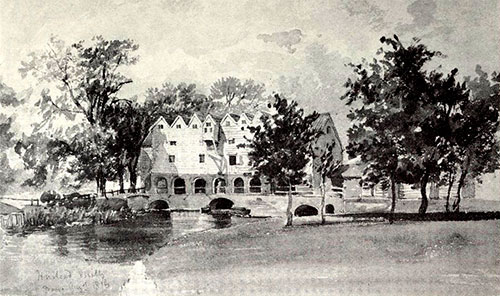 |
David Hodgson painting - 1816 |
Horstead Mill River Bure |
 |
David Hodgson painting - 1816 |
Horstead watermill was the last mill on the Bure, it was also one of the biggest, best known and most photographed mills in the county. |
There were two wheels, the largest was the older and was undershot with the other having been replaced by a more powerful turbine in later years. By 1957 only the turbine was being used to drive the mill mixing machinery. |
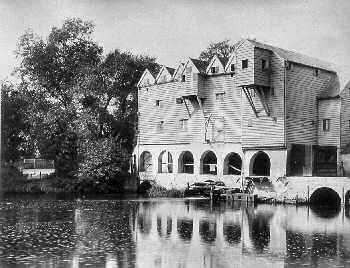 |
 |
c.1890 |
The wherry Widgeon c.1902
|
The final structure was probably built in 1789 to take two pairs of stones. The building was mainly of white weatherboard over a brick lower floor consisting of six dark brick arches. The pantiled roof section on the downstream side had six small matching gable sections with a seventh larger one to the right. The 4th and 7th gables bore lucums for the loading and unloading of wherries that came down the Aylsham Navigation, which had been completed in October 1779. |
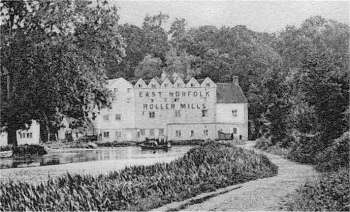 |
East Norfolk Roller Mills c.1900 |
Tuefday laft a journeyman miller at Horftead fetting up to work fell afleep in the meal trough, the flour by degrees rifing above his mouth, he was found in the morning fuffocated. |
Water Corn Mill to be Sold |
The spacious new built Water Corn Mill situate at Horstead in Norfolk within 7 miles of Norwich upon the Navigable river running to the Port of Great Yarmouth between which and the Mill there is no toll payable. The Mill is built on an improved plan, is capable of manufacturing 300 quarters of wheat weekly and is now in the occupation of Messrs Colls and Watts, the proprietors, who have mutually agreed to dissolve their Partnership at Michaelmas next at which time or sooner the Purchaser may have possession of the Mill. Norfolk Chronicle - 8th April 1797 |
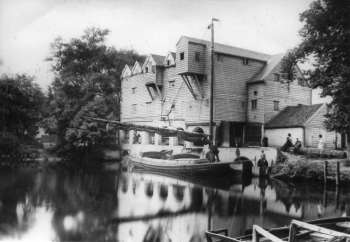 |
c.1902 with an unloaded wherry, probably Widgeon |
In May 1773 An Act of Parliament passed for making the River Bure Navigable. But the Navigation was not completed till 1779. It extends from Colteshall to Aylesham for boats of 13 Tons Burden & Cost sox thousand & one punds - To the Prejudice of the Trade of Horstead Mill..... and to the Great Damage of T J Batcheler, Esq's meadows & royalty from Colteshall to meyton Bridge. The land being frequently flooded & The Fish & Swans Disturbed or Stolen. |
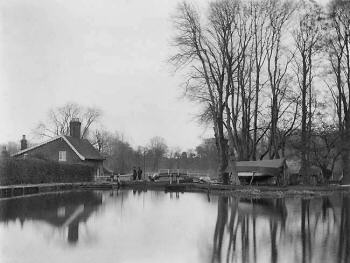 |
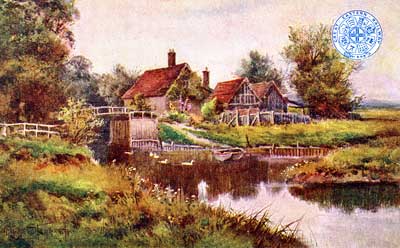 |
Coltishall lock c.1905 |
Great Eastern Railway postcard of Coltishall lock c.1907 |
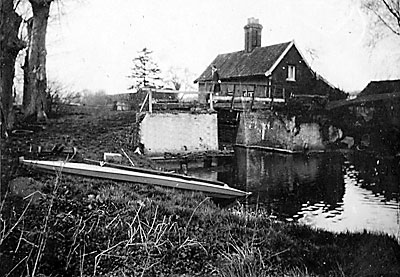 |
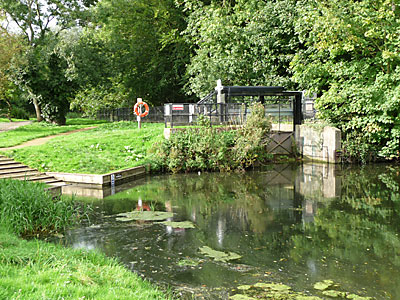 |
Coltishall lock house 1929 |
Coltishall lock 13th September 2008 |
Wind & Steam Mills. |
WIND & STEAM MILL TO BE LET with possession at Michaelmas next, the WINDMILL driving three pair of stones for Wheat and one pair for Barley and the Steam Mill adjoining driving three pair of stones. Situate at Stalham in the County of Norfolk. For particulars apply to Messrs. Clowes & Flowerdew, Norwich or Mr. Samuel Cooke, Horstead Mills. Norfolk News - 17th September 1859 |
St. Ann's Iron Works, King Street, Norwich, Feby. 12-1864. Mr. Cooke, Dear Sir, Having carefully gone through the items in reference to a New Water Wheel in Horstead Mills I find there will require three New Cast Iron Ring fitted and bolted together. All new float boards, Back boards and Oak Starts. Bolts and Nuts with Mens time fitting and fixing the same and taking out the old Wheel will be about one hundred and ten pounds and all the old materials. about £110.-.-. Waiting your reply, I am, Dear Sir, Your Obt. Servt, Thos. Smithdale. |
50 |
Back Boards 12" wide, 9ft long, 1" thick. | |
50 |
Float Boards 12" wide, 9ft long, 1" thick. | |
150 |
Struts, Oak 4" wide 2ft. 6" long 1" thick. | |
6 |
Extra Bolts about 72 long to bolt arms together. | |
150 |
Small Bolts repairing. | |
150 |
Bolts saything about 5". | |
150 |
Wedges about 8" long, 3" Wide, 2" thick. | |
24 |
Oak Wedges, 12" long 6" wide 2" thick for Hanging Water Wheel. | |
1 |
Stone of Gate Nails. | |
| Time for 3 men, 4 Weeks each. | ||
140ft. |
Oak Plank for Starts. | |
12ft. |
of 3" Poplar. | |
| Time 1 Week. |
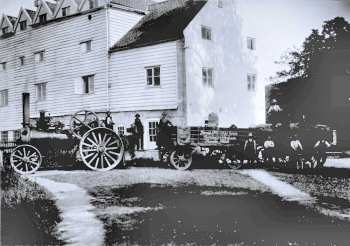 |
c.1905 The inscription on the cart reads: Thomas Phillippo Junior Contractor & Engineer Swanton Abbot |
HORSTEAD MILL |
By early evening on 2nd September 1939 Mr. Godbold, the Horstead Billeting Officer had placed all the evacuees in homes around the village – except two – a boy of thirteen and a seven year old girl, cousins. None of the households he had approached could accommodate these two children so he was immensely relieved when Mr. R. J. Read, the owner of Horstead Mill, offered to take them in. |
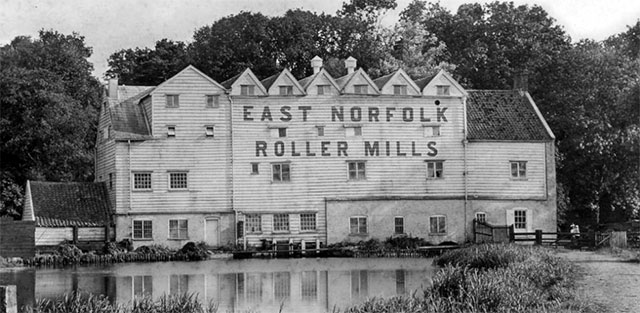 |
c. 1910 |
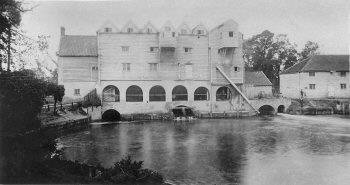 |
1917 |
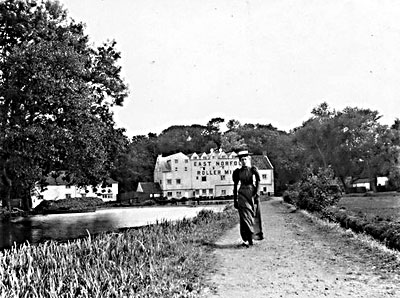 |
1919 |
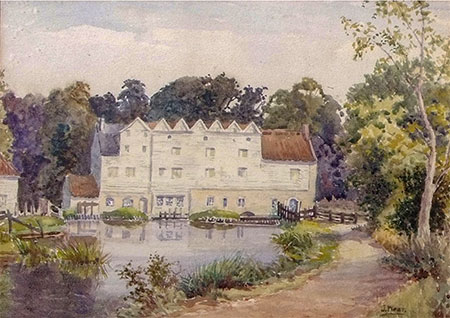 |
Joseph West painting c.1920 |
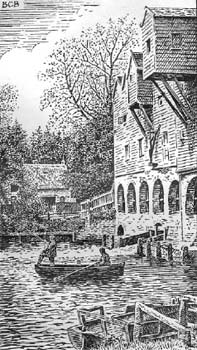 |
Drawing by B.C. Boulter c.1920 |
 |
 |
c.1920 |
c.1925 |
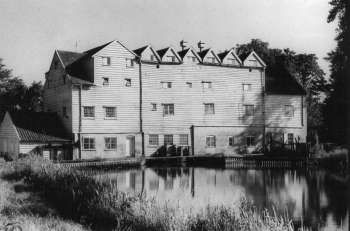 |
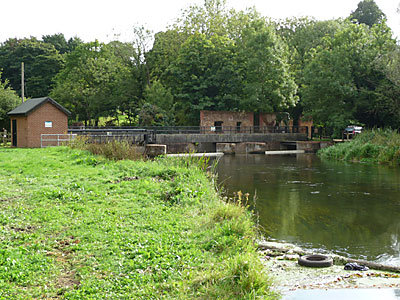 |
Mill dam c.1920 |
Mill dam 13th September 2008 |
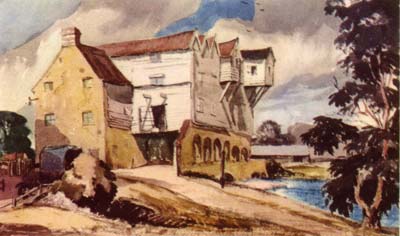 |
Watercolour by Leslie L.H. Moore c.1920 |
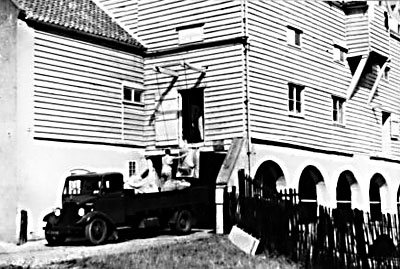 |
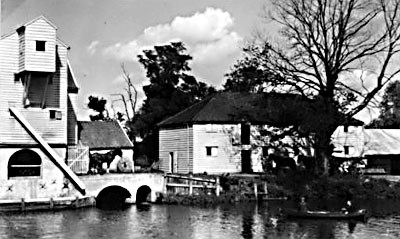 |
1935 |
Wheelhouse and granary 1935 |
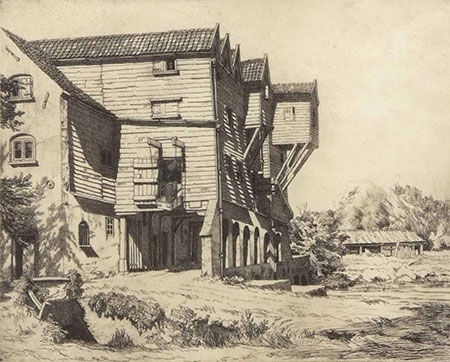 |
James Starling drawing c.1935 |
 |
Watercolour by James Fletcher-Watson - July 1945 |
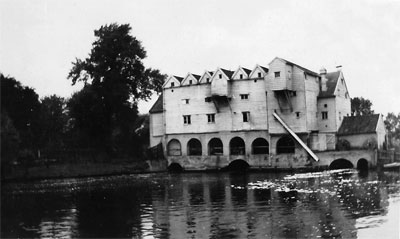 |
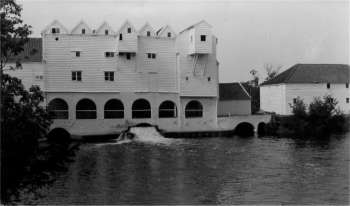 |
1942 |
Mill in its heyday c.1955 |
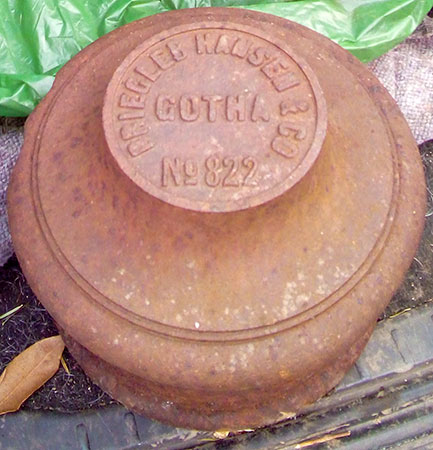 |
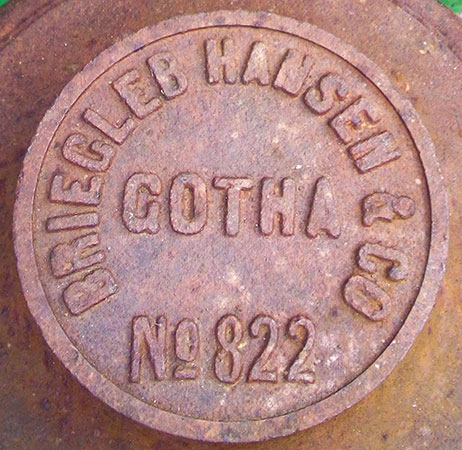 |
.Turbine cap end |
.Turbine cap end detail |
I am a Horstead resident born and bred remembering the mill from the mid 50s to date. Also as compilation editor of our community magazine, The Marlpit, am looking for information regarding the turbine fitted in the mill with fond memories of its groan when started and its swirling flow so much liked by the shoals of dace to be found there. |
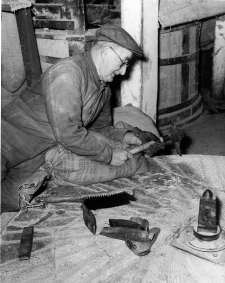 |
Jack Drayton stone dressing in 1960 |
It was nice to see a picture of my husband's uncle, Jack Drayton (stone dressing 1960). I believe it was taken from an Anglia TV documentary made about that time. |
William Woolston snr was listed as journeyman miller in the 1851 census and his son William was at that time working at Hoveton Steam Mill. |
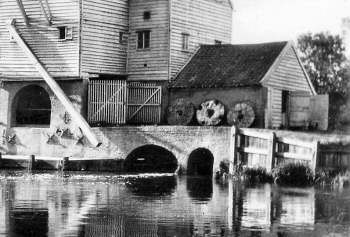 |
Millstones leaning against the wheelhouse July 1947 |
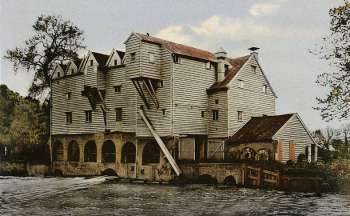 |
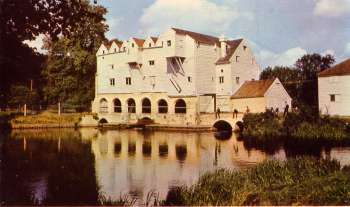 |
c.1900 |
c.1950 |
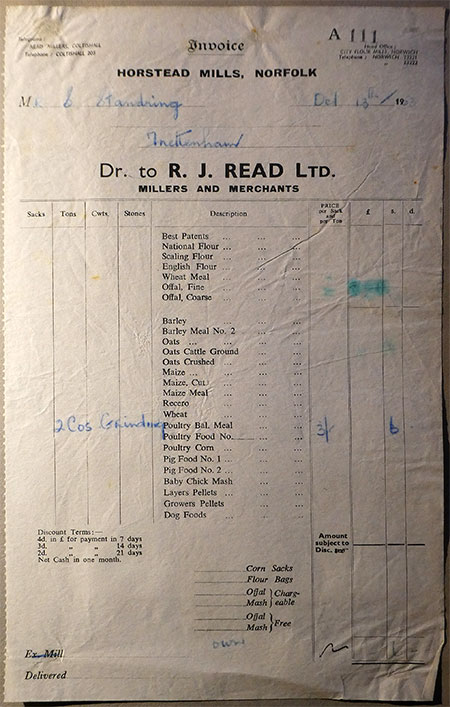 |
Mill invoice 13th December 1953 |
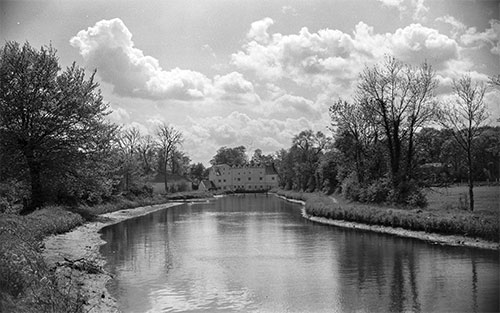 |
Mill working c.1955 |
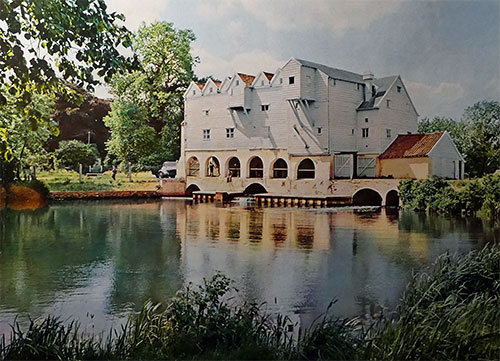 |
c.1960 |
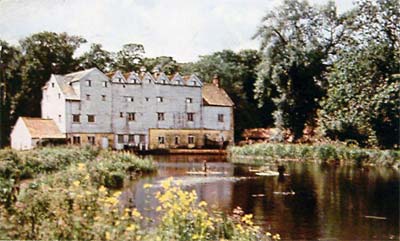 |
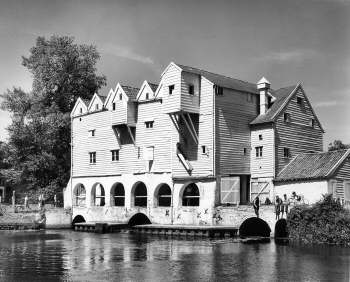 |
Mill dam c.1960 |
Millpool c.1960 |
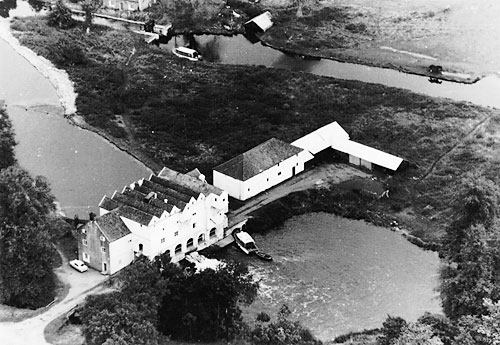 |
c.1960 with the lock keeper's house still standing top left |
Horstead Mill was gutted by fire on 23rd January, 1963, which was one of the coldest winter's in many years. Three appliances attended the blaze. Holes had to be carved in over a foot of ice in the river to allow access for the water hoses and the even then water froze on the ends. Although the fire was brought under control within an hour, it was too late to save the mill. It is thought the cause of the fire may have been an electrical fault. |
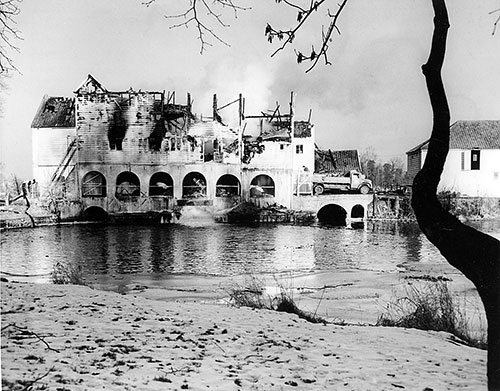 |
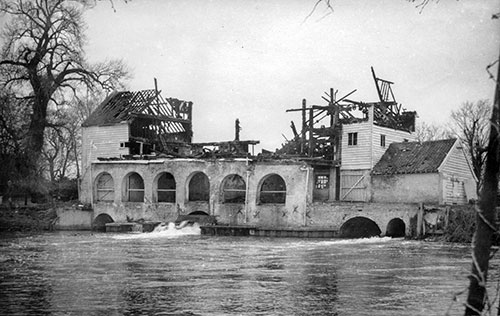 |
Still smoking - 24th January 1963 |
|
 |
24th January 1963 |
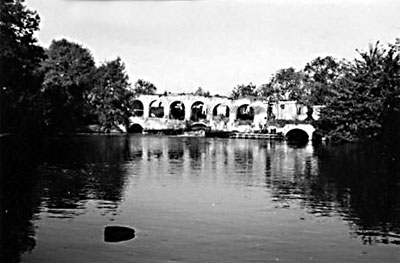 |
Mill remains - c.1964 |
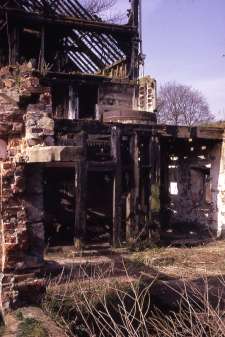 |
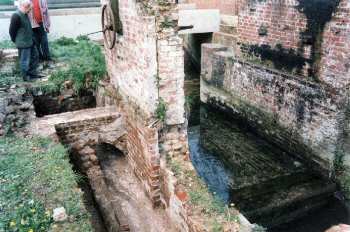 |
A millstone still sits on the first floor with its machinery beneath in March 1967 |
Wheel channels 29th April 1999 |
On 11th May 1973 the Eastern Daily Press reported that the East Suffolk and Norfolk River Authority had almost finished building a water gauging station on the mill site to measure the flow of the river. At this time Read's, who still owned the site, were contemplating a hotel using outline planning permission that had been granted some time ago but this did not come to fruition. |
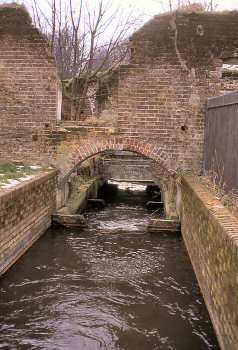 |
Wheelrace February 1983 |
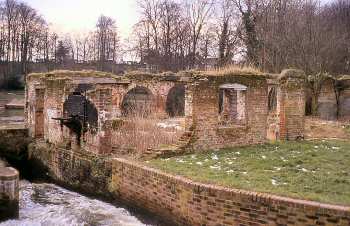 |
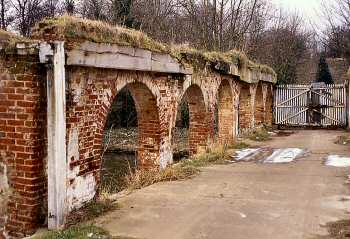 |
February 1983 |
February 1983 |
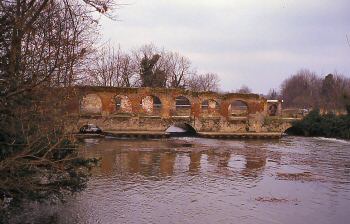 |
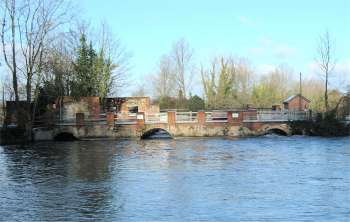 |
February 1983 |
9th January 2003 |
I bought a small notebook with some sketches and poems in at an antiques fair about ten years ago. I have recently been researching the owner. I have found this to be Harry Colls who is the great grandson of John colls the last Colls mentioned in the timeline on your website. John Colls son was a flour merchant in London, his son Lebbens was a picture dealer, and Harry Colls, his son, was an Artist and Draughtsman. His brother Walter was a photo etcher and engraver of some note, and is mentioned on many websites as being quite cutting edge in his time. I have researched some more on the family. |
Although the source of "Lebbens" as a name in the foregoing remains to be explained, it is certainly as reference to Ebenezer Colls, on whom the National Maritime Museum (which has a pair of paintings by him) has supplied the following note: |
I have written a book about my great grandfather called "The True Tale of Charlie Plant." under my maiden name Jane Sherwood. Charlie's great grandfather was John Colls (1744-1806) he married Elizabeth Everard in 1768 and they had 11 children between 1769-1788. His son Richard Colls (1775-1836) married Sarah Hood Ansell in 1802 and they had 6 children between 1802-1818 including my great great grandmother Mercy Colls, Charlies mother. The family fell on hard times, Charlie was born in the workhouse and orphaned at the age of 7. The following is an extract from my book which is available on Amazon as paperback and kindle with pages free to view. Chapter II. A Short History of the Family Colls. "Mercy's father, Richard Horton Colls, leased a large house in Hanover Square and owned a great deal of land and property in Norfolk. Mercy grew up in the country, at Horstead Mill, surrounded by many brothers, sisters, and several servants. The mill was owned and worked by her father and his father before him. They were Quakers and came from a long line of yeoman farmers, millers and corn merchants, who were highly respected in the city of Norwich. John Colls, Mercy's grandfather, was an overseer at Norwich Corn Market and a Trustee of the Town Lands, where he distributed his rent receipts to the poor. He was aquainted with the Gurney family and all business was carried out within the Quaker community. However. his son Richard, did not favour country life and eagerly took on the London Corn Market trade. Richard preferred the big city to parochial Norfolk, but still continued to run the mill after his father's death." I have illustrated the paperback version of the book and this image appears on page 14. 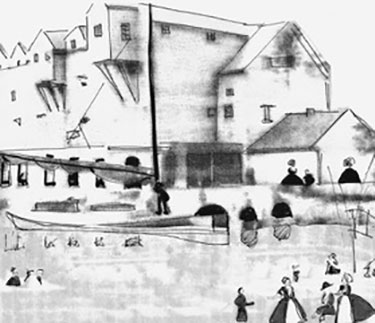 I hope you will find this interesting. Jane (Sherwood) Walter - 24th February 2019 |
Some time ago now we had a campaign to locate and photograph or scan many of the paintings of the mill owned by our readers. This is the link - https://www.themarlpit.co.uk/horstead-mill/ We are sure there are more and would appreciate hearing from anyone with a painting. |
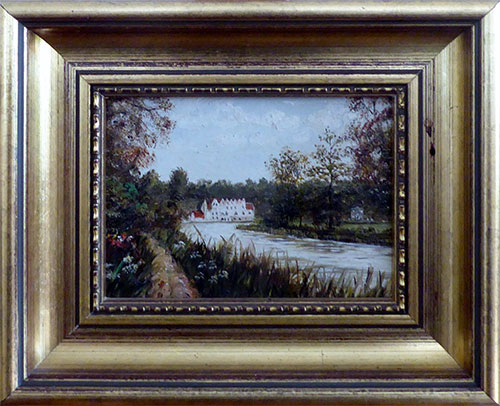 |
Oil on card painting by Maurice ? |
Idly surfing recently because of a query from a relative (and because I passed through Horstead and Coltishall on holiday last week), I stumbled on the website for Horstead Mill again.
As reported by my wife Ruth in 2006, my uncle, Jack Drayton, was the last Head Miller and my father and mother (Leslie and Audrey Durrell) lived with him, his wife (the Horstead teacher Ida Drayton) and her mother (Annie Durrell) during the War, when I was born, moving (unwillingly) to Manchester in 1946, where I grew up (and still live). However, we stayed in Horstead for pretty well the duration of every school holiday until I went to University and I used to go down to the Mill with my uncle nearly every day before breakfast. I think I can probably still remember every corner of a place which is one of my fondest childhood memories.
Two things I recall in particular were the continual battle between my uncle and the person who he regarded as a total incompetent who was in charge of the mill at Buxton, who would always mismanage the water flow coming downstream to Horstead. And the eel trap on the right hand side looking back from the mill pool which was a valuable extra income source, as the eels would be collected regularly and sold to be jellied in London.
My grandfather, Hay Joseph Durrell, was Chief Clerk at the Mill in the early 20th century until 1912, when - as I was eventually told, since it was for long a closely guarded family secret - he ran off with a girl from a visiting fair or circus. I never knew him, of course, but he was apparently still alive in the early years of the War.
During one visit, probably in the 1950s, my father bought a small picture (oil on card) of the Mill which I still have. I have a not altogether clear recollection that it was painted by a local man called Maurice (or Morris?) - surname unknown, but he must have been well known in Horstead or Coltishall.
Martin Durrell - 16th August 2020 |
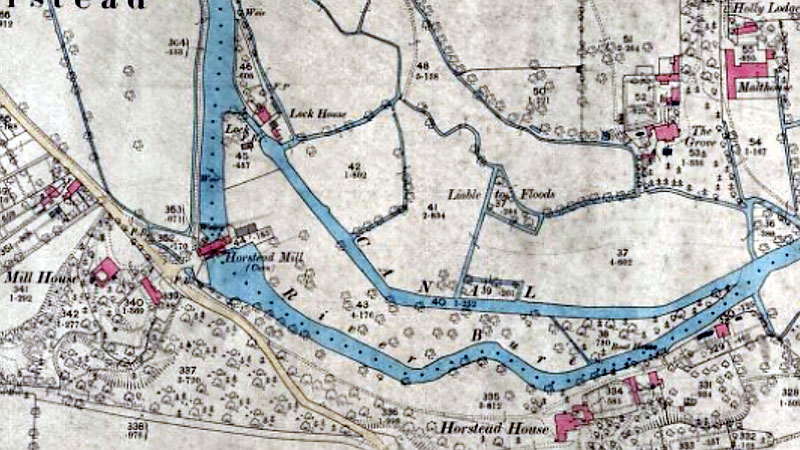 |
O.S. Map 1880 Courtesy of NLS map images |
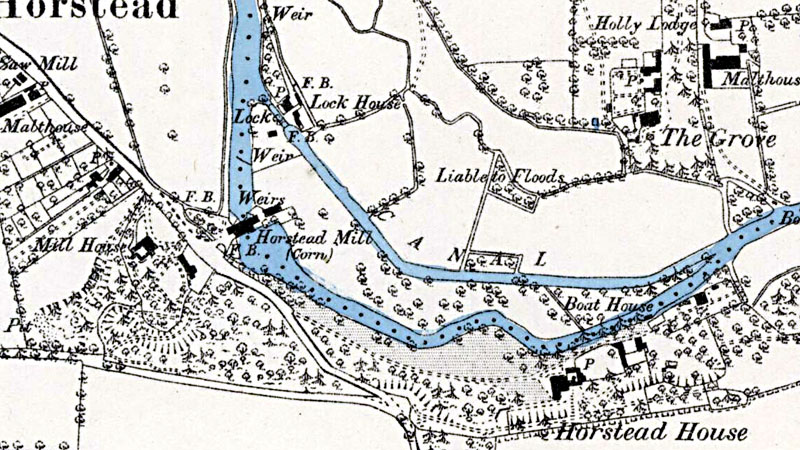 |
O.S. Map 1881 Courtesy of NLS map images |
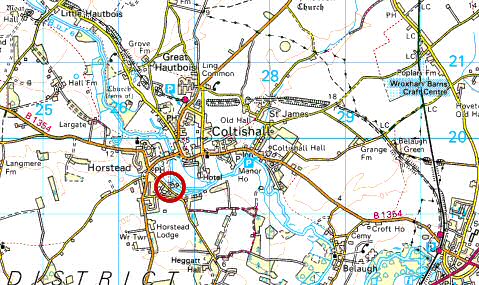 |
O.S. Map 2005 Image reproduced under licence from Ordnance Survey |
College survey 1586: Two water-mills, one a grist-mill and the other a fulling-mill
White's 1854: Cooke & Gambling, corn millers
Kelly's 1883: Samuel Benjamin Cooke |
If you have any memories, anecdotes or photos please let us know and we may be able to use them to update the site. By all means telephone 07836 675369 or
|
| Nat Grid Ref TG 26711936 | Copyright © Jonathan Neville 2006 |